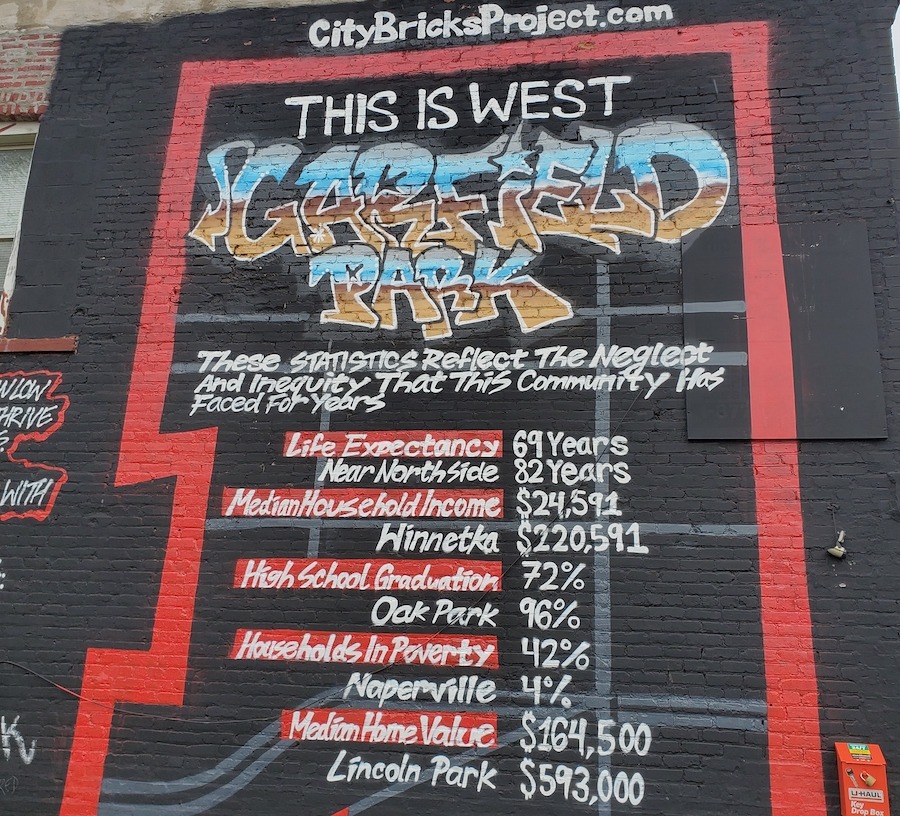Lake Shore Drive is now named after Jean Baptiste Pointe du Sable, the Haitian founder of Chicago. The city added an “s” to Douglas Park, changing its namesake from White supremacist Stephen Douglas to abolitionist Frederick Douglass. Last week, Mayor Lori Lightfoot dedicated a monument to journalist Ida B. Wells in Bronzeville.
Chicago is doing a great job of honoring the historical contributions of African-Americans. But these honors are going up even as life is becoming more difficult for African-Americans here. No matter how many monuments to racial equality we erect, the fact remains that Chicago itself is a monument to racial inequality—and that inequality is getting worse.
Consider this statistic on the mural above at Madison and Kostner in West Garfield Park, a neighborhood that is 95 percent Black, a result of Chicago’s history as one of the nation’s most segregated cities: The median home value in West Garfield Park is $164,500, compared to $593,000 in Lincoln Park.
It wasn’t always this way. In 1970, the median household incomes of West Garfield Park and Lincoln Park were nearly identical: $37,363 vs. $40,929, adjusted to current dollars. Today, West Garfield Park has an income of $23,857, while Lincoln Park’s is $100,326. In 1970, Chicago’s Black unemployment rate was 6.9 percent, compared to 3.5 percent for whites. By 2016, the gap was 21.9 percent to 4.9 percent. In 1980, Black wages were 4.6 percent lower than white wages. Now, they’re 21.9 percent lower.
What happened over the last 50 years? The social and economic factors that have destroyed the American middle class—globalization, outsourcing, the loss of blue-collar industrial work—have fallen particularly hard on Chicago’s Black community. The manufacturing jobs that drew African-Americans to Chicago during the Great Migration have disappeared, and they haven’t been replaced by equally well-paying work.
“While service, retail, and information sector jobs replaced lost manufacturing employment in many North Side neighborhoods, these developments did not occur to a similar extent in the South and West Sides of the city,” according to “Between the Great Migration and Growing Exodus: The Future of Black Chicago?”, a report by the UIC Institute for Research on Race and Public Policy. “Because major manufacturing companies served as anchors of employment and indirectly supported local neighborhood economies, many majority black neighborhoods in the city declined as jobs and economic opportunities continued to vanish.”
A map of Chicago’s middle-class Census tracts shows that, in 1970, they were spread evenly throughout the city. Now, most of the South and West sides are low-income, while the north lakefront is very high income. This maldistribution of resources has also resulted in a maldistribution of violence. A 2013 analysis by Daniel Kay Hertz found that in the early 1990s (when Chicago had 900 murders a year), the most dangerous neighborhoods in Chicago were six times more violent than the safest neighborhoods. By the late 2000s, the most dangerous neighborhoods were 15 times more violent. Blacks are 17 times more likely than whites to get shot in Chicago. The city’s murder rate is down from its all-time high, but most of the gains in safety have taken place in areas that are thriving economically.
Fewer jobs and more violence results in population loss: since 1970, West Garfield Park has lost 63 percent of its residents. Citywide, Blacks were once Chicago’s largest ethnic group, but as their numbers have declined from 1.2 million in 1980 to 780,000 today. They’ve fallen behind whites, who are swelling the populations of Lake View, Lincoln Park and the Loop. This is imperiling Chicago’s position as the nation’s Black Political Mecca—home of more Black congressmen than any other city, training ground of the first Black president. On the City Council, two Black wards have flipped to other groups, and Blacks may be hard pressed to maintain their numbers in Congress and the legislature.
The legacy of segregation, it turns out, may be more enduring and harder to overcome than the legacy of Jim Crow. A report by the Corporation for Enterprise Development found that Chicago’s racial wealth gap is worse than the nation’s as a whole. The median household income for Blacks here is $30,303, compared to $70,960 for whites. It’s even worse than Mississippi, the state so many Blacks fled for Chicago during the Great Migration. In Mississippi, median Black income is $32,965. Illinois’s Black murder rate—36.4 per 100,000—was three-and-a-half times higher than Mississippi’s as recently as 2016.
The UIC study found that many of the economic incentives that drew Blacks to the North during the 20th Century have been reversed, with the South now offering more equality and opportunity:
Comparing black/white wage gaps in Chicago and three Southern cities from where a large number of blacks emigrated in the mid-20th century, wage discrimination in Chicago was much lower than in comparable Southern cities from 1940 through 1980,” the report’s authors wrote. “This is consistent with the pervasive narrative that blacks were moving away from the discriminatory South to the North, where economic opportunities were more readily available and racism was less prevalent. After 1980, however, racial wage gaps in Chicago worsened, becoming similar to many Southern cities in 1990 and 2000, and then worse than many Southern cities in 2010 and 2016. In 2010, for example, the black/white wage gap in Chicago, at 22%, was ten percentage points worse than the wage gap in Columbia, South Carolina, at 12%.”
In racial symbolism, Chicago can continue to claim moral superiority over the South. We don’t have any monuments glorifying the Confederacy. We didn’t vote for Trump. Illinois’s entire congressional delegation voted to make Juneteenth a federal holiday, while a handful of Southern Republicans voted no. But on matters of racial equality, the Land of Lincoln can no longer claim to be better than the South. We are, in fact, looking worse.




Comments are closed.